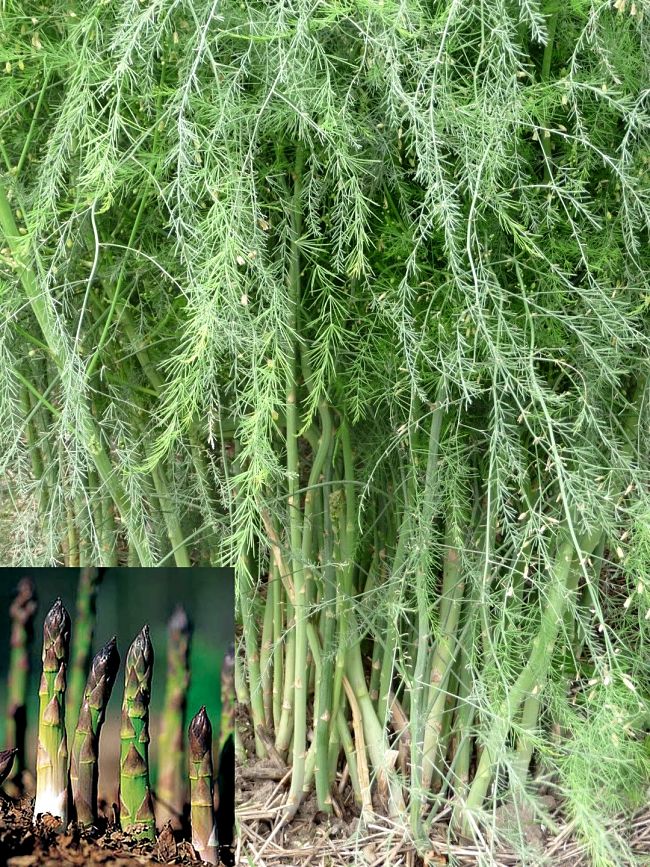Understanding Asparagus Plant Basics
Asparagus, a delightful perennial vegetable, graces gardens with its feathery foliage and delectable spears. Knowing how to grow asparagus plants begins with understanding its nature. This plant is not an annual; it returns year after year, offering a consistent harvest once established. Asparagus comes in several types, each with unique characteristics. Green asparagus, the most common, presents a vibrant green hue and a classic flavor profile. Purple asparagus offers a sweeter, nuttier taste, and a visually appealing color. White asparagus, a delicacy, is grown in the dark, resulting in its pale color and tender texture. These different varieties impact the flavor and texture of your harvest. Grasping these fundamental aspects of asparagus growth is paramount for successful cultivation and knowing how to grow asparagus plants properly. The way asparagus plants grow affects how we plant and maintain them.
The growth habit of asparagus is quite interesting. It emerges from crowns, which are underground rhizomes that store energy. These crowns send up spears in the spring, which are the edible parts we harvest. If not harvested, these spears develop into tall, fern-like foliage. Understanding this growth cycle is essential for deciding when and how to harvest. Knowing how to grow asparagus plants involves caring for the ferns too. The ferns are crucial because they replenish the crown’s energy reserves for the next year’s growth. Neglecting to care for the ferns could mean reduced production in following seasons. Therefore, successful asparagus cultivation involves a deep understanding of the plant’s lifecycle. This includes its perennial nature, variety types, and growth habits.
How to Plant Asparagus: A Step-by-Step Guide
Planting asparagus requires careful attention to detail to ensure a successful and productive crop. Whether starting from crowns or seeds, the initial steps are crucial for long-term growth. Begin by selecting a suitable location. Asparagus plants thrive in full sunlight. They need at least six to eight hours of direct sun each day. The soil must be well-draining and fertile. Heavy clay soils should be amended with plenty of organic matter like compost. This improves drainage and provides essential nutrients. The ideal soil pH for asparagus is between 6.5 and 7.5. A soil test can help determine the existing pH level. Amend with lime if the soil is too acidic. When planting from crowns, dig trenches that are 6 to 12 inches deep and 18 inches wide. Space the trenches at least 3 to 4 feet apart. Place the crowns at the bottom of the trench, with the buds facing upwards. Cover the crowns with 2 inches of soil. As the plants grow, gradually fill in the trench. Planting from seeds requires starting indoors several weeks before the last expected frost. Sow seeds in a seed tray at a depth of about half an inch. Once seedlings have developed several sets of true leaves, transplant them into the garden. This method is slower, but can be cost effective. Proper spacing is vital for how to grow asparagus plants successfully. Plants need enough room to develop without overcrowding. Adequate spacing allows for good air circulation.
The best time to plant asparagus is early spring, after the last frost. This allows the plants to establish themselves before the heat of summer. Planting in the correct season is essential for vigorous growth. Asparagus requires consistent moisture, especially during the first year. Water deeply when the soil feels dry to the touch. Mulching helps retain soil moisture, suppress weeds, and regulate soil temperature. Use organic mulches such as straw or wood chips. Fertilizing asparagus at planting time is important. Use a balanced, slow-release fertilizer and work it into the soil. Throughout the growing season, avoid using high nitrogen fertilizers. These fertilizers promote fern growth instead of spear production. Knowing how to grow asparagus plants also involves monitoring soil health. Regular soil testing is recommended to adjust fertilization practices. Once established, asparagus is relatively low-maintenance but still requires consistent care. By following these guidelines, you can achieve a thriving asparagus patch.
Optimal Care for Thriving Asparagus
Providing the correct care is essential for successful asparagus cultivation. Consistent watering, especially during the initial establishment phase, is crucial for how to grow asparagus plants. Young plants require regular moisture to develop strong root systems. Water deeply and less frequently, rather than shallow and often. This practice encourages roots to grow downwards seeking moisture. Mulching around the base of asparagus plants is highly beneficial. Apply a layer of organic material such as straw, wood chips, or compost. Mulch helps retain soil moisture, suppresses weeds, and regulates soil temperature. These actions collectively foster healthy growth. Proper fertilization is another vital aspect of asparagus care. Apply a balanced fertilizer in the early spring. Use a fertilizer that is rich in phosphorus and potassium. These nutrients are essential for root development and spear production. Avoid over-fertilizing with nitrogen. This may lead to excessive fern growth at the expense of spear quality. The best time to fertilize is just before or during the beginning of the growing season. Following these practices is key to nurturing robust and productive asparagus plants. Remember that consistent care provides the best results for how to grow asparagus plants.
Understanding the specific needs of asparagus will yield plentiful harvests. Consistent care is crucial for establishing healthy plants. Monitor soil moisture regularly, especially during dry periods. Water deeply but ensure good drainage to prevent root rot. Mulching plays a critical role in maintaining optimal soil conditions. A thick layer of mulch not only helps conserve water but also suppresses competing weeds. This process ensures that the asparagus plants receive adequate resources. These care techniques contribute to the overall health and vigor of your plants. Regular fertilization helps maintain a good nutrient supply throughout the growing season. Using a balanced, slow-release fertilizer provides the essential elements that asparagus requires. This ensures consistent spear growth and overall plant health. This also ensures the best method on how to grow asparagus plants. Careful attention to these care aspects will promote a strong and fruitful asparagus patch. Remember that dedicated care translates directly to the quality and quantity of your harvest.
Harvesting Asparagus: When and How
The timing of the asparagus harvest is crucial for ensuring both the current yield and the plant’s long-term health. Initially, allow young asparagus plants to establish themselves for the first two to three years without harvesting. This allows their root systems to develop fully. Once established, the harvesting window typically begins in the spring, when the spears are approximately 6 to 8 inches tall. The ideal spear for harvesting is thick, firm, and tightly closed at the tip. To harvest, gently snap or cut the spear at or below ground level. Take care not to disturb the surrounding soil or nearby spears. It is important to understand the “cut and come again” nature of asparagus harvesting. Harvesting can continue for about 6 to 8 weeks, depending on the variety and climate, with new spears emerging regularly during this period. Knowing how to grow asparagus plants involves a keen understanding of this cycle.
As the harvest season progresses, some spears should be allowed to grow into ferns. These ferns are crucial for the plant’s health. They photosynthesize and store energy for the next season’s growth. Cease harvesting when the spears become thin and less vigorous, and instead focus on plant maintenance. It’s important to leave several spears to develop into these feathery ferns. This practice nourishes the plant’s crown and allows it to build up its strength for future harvests. If you’re wondering how to grow asparagus plants successfully, understanding this aspect of the plant’s life cycle is key. The correct harvest and subsequent care practices will dictate future crop success. This method is fundamental for continued production in subsequent years. When harvesting, choose spears that have the appropriate size and firm texture.
Regularly check your plants during the harvest season. This helps to identify spears that are ready to be picked. Proper harvesting methods prevent damage to the crown. They also ensure consistent growth and prevent spears from becoming too woody or bitter. By observing these practices on how to grow asparagus plants, you can enjoy a robust and sustainable harvest for many years. The process of carefully selecting spears for harvest, while also allowing for fern development, is a balance essential for success. This is fundamental knowledge for the home gardener.
Troubleshooting Common Asparagus Growing Problems
Growing asparagus can be rewarding. However, challenges may arise. Pests, diseases, and weeds can impact your yield. Understanding these issues is crucial. Early identification is key. This allows for prompt action. Asparagus beetles are common pests. They eat foliage and spears. Aphids also pose a threat. They suck sap from the plants. Diseases like fusarium wilt can be devastating. It causes yellowing and wilting. Rust is another fungal disease. It appears as orange pustules. Weeds compete for resources. They rob asparagus plants of nutrients. These problems can hinder the growth of asparagus. It is important to know how to grow asparagus plants effectively.
Prevention is often the best approach. Regular garden checks are beneficial. This allows you to catch issues early. Encourage beneficial insects. They can prey on harmful pests. Handpicking beetles and aphids can work for small infestations. For fusarium wilt, ensure good soil drainage. Avoid overwatering. Select disease-resistant varieties when possible. For rust, improve air circulation. Remove affected foliage. Natural and organic controls are preferred. Neem oil can manage many pests. Insecticidal soaps can control aphids. Organic fungicides can treat rust. Weeding regularly is important. Mulching helps suppress weeds. These methods are key for how to grow asparagus plants successfully.
Careful monitoring can ensure healthy plants. Consistent action is crucial. Combining preventive practices with organic solutions provides long-term benefits. Address issues as they occur. By doing so, you protect your plants. You also improve the likelihood of a bountiful harvest. Understanding how to grow asparagus plants includes managing these challenges effectively. This will result in healthier plants and a more successful garden. It also contributes to a more sustainable gardening approach. It ensures a high-quality yield for years to come.




